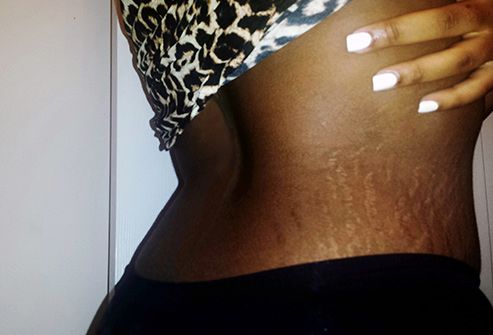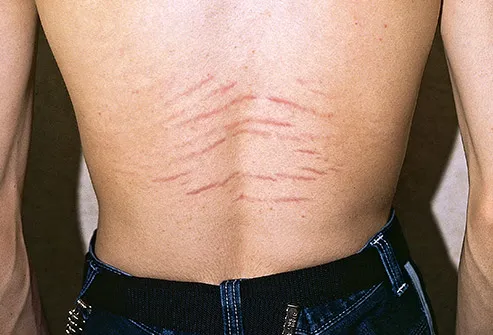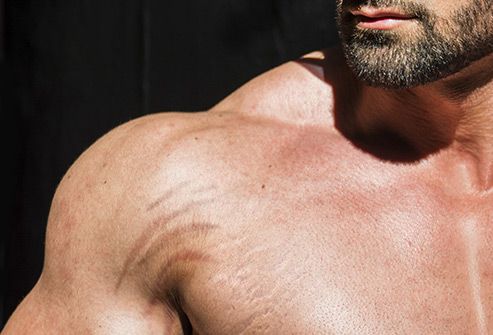Stretch Marks: Causes and Treatment
Stretch Marks

Stretch marks are set-in streaks that show up on your stomach, breasts, hips, butt, and thighs. These long, thin, rippled marks are also called stria. If you have stretch marks, you probably wish they’d go away. These grooves or lines in your skin aren’t harmful to your health, but they aren’t great to look at, either.
And even though they’ll never really go away, they might fade over time or with help from certain products and procedures.
Stretch Marks Causes and Risk Factors
Stretch marks happen when your body grows quickly for any reason. Your skin can’t stretch enough to keep up.
Collagen is a protein that makes your skin more elastic. If your skin doesn’t have enough, the marks may show up as it stretches.
You may get stretch marks because of:
Quick weight gain (this affects both men and women)
Childhood growth spurts during puberty. Make sure kids know this is normal and that childhood marks may fade as they get older.
Pregnancy as a result of stretched skin and a surge in hormones that weakens skin fibers. They might fade as you shed pounds after the baby is born.
Breast implant surgery
Bodybuilding,even those who have little fat can get them where their muscles bulge
High amounts of steroids, either from steroid medications or illnesses like Cushing's syndrome
Marfan syndrome, a genetic disease that weakens your skin fibers and causes unusual growth
Ehlers-Danlos Syndrome (EDS), a group of conditions that result from genetic changes to collagen, a protein in your body
They also run in families.
Stretch Mark Symptoms
New stretch marks may feel slightly raised and itchy. These rippled, streaky lines in your skin come in different colors. They fade from red or pink to purplish-blue to thinner, pale, more scar-like streaks over time. You may not notice them as much.
Stretch Mark Treatments and Home Remedies
A range of medical treatments and home remedies is available to treat your stretch marks. Some work better than others.
Medical treatment for stretch marks
A skin doctor or plastic surgeon can use lasers or other treatments to help fade the marks. It may help your skin make more collagen:
Pulsed dye laser therapy is a painless blast of light used on new, red stretch marks. The light’s energy calms blood vessels under your skin that could cause the marks.
Fractional CO2 laser therapy is a new treatment that may smooth out old, white stretch marks. One study showed that women’s stretch marks faded after five sessions compared to others who used topical creams with glycolic acid and tretinoin.
Excimer laser therapyexposes stretch marks to targeted ultraviolet B (UVB) light. A small study shows that it’s safe and treatments over 1 to 4 months can correct pigment problems from stretch marks.
Microdermabrasion uses tiny crystals to rub off the top layer of your skin. One new study showed that this treatment helped fade new, reddish stretch marks when combined with skin peels.
Cosmetic surgery, like a tummy tuck, may remove skin with stretch marks. But these operations could leave scars. Plus they’re often painful and costly.
Chemical peelis an acidic solution that burns off the top layers of your skin to remove dead and damaged cells and boost new skin growth. This treatment may improve your stretch marks a little, but won’t completely get rid of them.
Radiofrequency uses radio wave energy to create heat and trigger your body to make collagen. One small study found this treatment is safe and can improve stretch marks, but scientists need to do more research.
Ultrasound works a lot like radiofrequency treatments. The procedure sends sound waves deep into your skin to heat and tighten and jumpstart collagen production.
Home remedies for stretch marks
You’ll find many creams, salves, oils, and other skin ointments that claim to either prevent or treat them. But there’s little proof that any of these products really work. Some treatments and home remedies can fade or hide stretch marks:
Body makeup and self-tanner: These products can help hide stretch marks. Note that tanning won’t get rid of stretch marks. It actually makes them easier to see.
Tretinoin: Creams with tretinoin (Retin-A) contain retinoid, a compound related to Vitamin A. Retinoids increase collagen production. They’re often used to treat wrinkles. They may help fade newer stretch marks, but they can also make your skin red, irritated, or scaly.
Collagen boosters: StriVectin-SD and lupin seed extracts are both supposed to increase collagen in your skin, but it’s hard to say if they’ll fade or prevent stretch marks.
Centella asiatica: This herbal oil boosts cells in your body that make collagen and build up skin tissue. Some people use it to help heal wounds. Centella asiatica is in a number of over-the-counter skin creams for stretch marks, but there’s little proof it helps to fade them.
Bitter almond oil: One study showed that women who massaged bitter almond oil into the skin on their bellies during pregnancy had fewer stretch marks than others who just used oil without massage.
Cocoa butter, shea butter, olive oil, vitamin E oil, and other moisturizers: These natural creams can make your skin feel softer, but it isn’t clear if they help or prevent stretch marks.
If you decide to try a cream, lotion, or gel to fade your stretch marks, be sure to use it every day for several weeks. Take the time to massage it into your skin. These products may work best on newer stretch marks.
There are many reasons why stretch marks might appear. Here are a few:
- Rapid muscle or weight gain
- Family history
- Pregnancy
- Undergoing breast enlargement surgery
- Having a genetic condition like Cushing’s or Marfan syndrome that weaken the fibers of your skin and cause atypical growth
- Being overweight
- Bodybuilding
- The use of steroid medications
Where You Get Them

Anyone Can Get Them

Cause: Weight Gain

Cause: Pregnancy

Cause: Medical Conditions


Can You Prevent Them?
Experts think genetics play a role in stretch marks, but if your parents had them, that doesn’t mean you will, too. One of the best ways to prevent them is to keep your weight steady. Drinking plenty of water may help prevent damage when your skin stretches. And foods that keep your skin healthy may cut your odds, too. Eat foods rich in zinc, like nuts and fish, and ones with vitamins A, C, and D, like citrus, milk, and sweet potatoes.
What May Help: Retinol Products

Retinol, which comes from vitamin A, may help make stretch marks less obvious. It makes your skin cells shed, or “turn over,” faster and may make new skin grow faster, too. The catch: You have to start using it soon after stretch marks show up, and then use it regularly for it to work. And the type of retinol that’s been shown to work (tretinoin) is only available by prescription. Talk to your dermatologist about whether you should try
What May Help: Laser Therapy

The American Society for Dermatologic Surgery says laser or light therapy can make stretch marks less noticeable -- light triggers skin changes that help stretch marks blend in. Research shows they’re most effective for medium-tone skin. Laser treatments can be expensive, and it can take 20 sessions to see results. If you go the laser route, see a board-certified dermatologist or plastic surgeon who has worked with your skin tone.